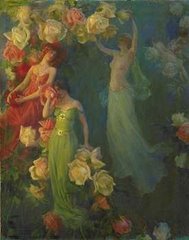

Do the chemicals: 6-methyl-5-hepten-2-ol or
1,3(E),5(Z)-undecatriene or 1-p-menthene-8-thiol sounds like dangerous chemcials to you, or would you hear any alarm bells when you know that these chemicals were ingredients of the perfume you are wearing right now?
Probably because you don't know what these names stands for they can sound like intimidating names. Unknown names or things we don't understand can scare us sometimes. In fact these chemicals are just aromatic chemicals that are found in nature. 6-methyl-5-hepten-2-ol is a component of natural Yuzu oil, you can read about this chemical here.1,3(E),5(Z)-undecatriene is a component of natural Galbanum oil, you can read about this chemical here.1-p-menthene-8-thiol is a component of natural Grapefruit oil, you can read about this chemical here.
Every living thing, including you and me, is made of millions of complex chemicals. Natural essential oils are blends of many chemicals. The word "chemicals" has become an emotionally-loaded word and has a negative sound to some people because virtually the only time the media reports about it, it's a negative report. The word "synthetic" is looked upon with suspicion, at best. Conversely, "natural" is often thought of as inherently harmless. Natural does not equal safe and synthetic does not equal unsafe.

Tony Burfield from Cropwatch wrote an article about chemophobia he said that the finger of suspicion is also pointing at fragrance volatiles - one is tempted to say, raising it to a level of near-paranoia. He writes about an article that Pat Thomas once wrote where he suggests that there is no difference between conventional perfumes and pollution, saying 'fragrance chemicals...include...many other known toxins capable of causing cancer, birth defects, central nervous system disorders and allergic and asthmatic reactions. Pat Thomas discussing fragrance chemicals found in the perfume Eternity Eau de Parfum (Calvin Klein). Here are some examples of fragrance chemicals that he described as being harmful:
Benzyl acetate – said to be irritant and also said to be linked to pancreatic cancer.
Benzyl acetate occurs in jasmin, narcissus & hyacinth head space odours and in gardenia oil, ylang ylang oil & cananga oils.
Eugenol – said to be an irritant, a cause of contact dermatitis, pesticide & insecticide ingredient.
Eugenol occurs in the head space of hyacinth flowers & carnation flowers; and in the oils of clove, cinnamon leaf, pimenta berry, W.I. bay oil, & basil oil CT linalol.
Benzaldehydehyde, 4-hydroxy-3-methoxy (aka vanillin) – irritant to mouth throat eyes etc... kidney damage, CNS disruption
Benzaldehydehyde, 4-hydroxy-3-methoxy occurs in vanilla beans, peru balsam, & benzoin resinoid.
Tony Burfield also says:
"Of course in the real world, toxic effects of chemicals are directly related to the dose, and splashing 0.03 ml of alcoholic perfume containing minor concentrations of these components behind the ears is unlikely to promote the effects listed above, even in a small minority of extremely susceptible individuals. Further, many of these components identified are identical to those components naturally occurring in the scents emitted from flowers, meadows & pine forests, or are responsible for the odour & taste of spices and natural flavourings etc. – so what are we to do? Mow down all the flowers and trees, since they give off these dangerous
volatiles? "
End quote.
Yes there are dangerous and toxic chemicals and yes there are dangerous and toxic naturals, but that doesn't mean you can group them all together and say that all chemicals and all naturals are bad and toxic.
Toxic ingredients have to be banned out of our perfumes, that's for sure. That's why Ifra made a guideline to tell us which ingredients should not be used or tell us the amount of ingredients we can safely use in our perfumes.
Here are more links about chemophobia:
http://members.tm.net/lapointe/ChemTox.htm
http://www.heartland.org/Article.cfm?artId=919
http://www.crscientific.com/chemophobia.html
http://www.heartland.org/Article.cfm?artId=919
http://www.crscientific.com/chemophobia.html
Have a fragrant safe day!











4 comments:
Dear Jenny
Thank you for this post. It looks as if the sum of all fears remains constant. Thus, (phrased perfectly today by Luca Turin in his NZZ Folio Scent Note), people compensate and are supported by the media and politicians. Because it is easy to feed the fear ...
Dear Andy,
Thank you for bringing 'Scent Note' up, I just read it. I find it horrible that Ifra restrict or ban materials that cause a little itchy skin to only a vew people. Take 1000 people and you will see that there will always be one who is allergic to something. It's impossible to creat an all allergic free product.
I understand that Ifra has to ban toxic ingredients and restrict ingredients that cause allergic reactions to most people, but they restrict or ban every POSSIBLE allergen, even when it's causing just only a vew people an itchy skin. Think about how long your label will be when you have to name every possible allergen in your perfume!
At least: IFRA does not prohibit. It just recommends.
I find -on the other hand- IFRA's rule helpful to identify limits, thresholds. EU regulations however are absolutely useless. 0.01% of this or that!
But I nevertheless label according to EU regulations.... I think it is importantt to give customers a choice and chance to identify potential alergens. I really think this is the key. Those who are affected by alergies must have the possibility to make a decision.
Fragrant EU neutral and IFRA compatible wishes ;-)
Dear Andy,
Yes that's true they're only recommendations. And I always use the list too to check if a material is safe or how much I can use of this material. I wonder though, can you for example use oakmoss on a higher doses than their recommendation when you put it on your label? I'm very confused about all these things. I talked about the Ifra and the rules of the EU regulations on the group as well and don't understand it very well.
I would like it if we could choose if we want for example a perfume containing more oakmoss than the recommendation, is that still possible?
Post a Comment